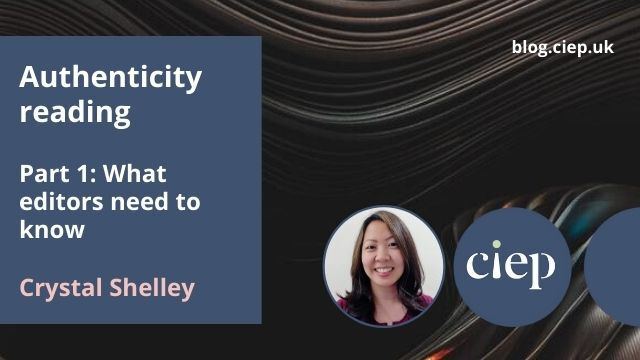Authenticity reading, often called sensitivity reading, is a service that all editors should know about, because it plays a valuable role in the publishing process. In the first part of this two-part series, Crystal Shelley explains what authenticity reading is and isn’t, why it’s important and how editors can help their clients by recommending it when relevant.
Here’s what this post will cover:
- Authenticity reading at a glance
- Topics that authenticity readers assess
- Common misconceptions
- The value of authenticity reading
- Recommending this service to clients
 Authenticity reading at a glance
Authenticity reading at a glance
People want to see themselves, their identities and their experiences reflected accurately in media, but too often the representation on screen or in writing is problematic. One way in which writers can craft stories or text that’s accurate, respectful and validating to those being represented is to hire authenticity readers.
Authenticity readers, commonly called sensitivity readers, evaluate the way an identity or experience is portrayed in writing. They’re usually hired when a writer is writing about topics outside their lived experiences, where it’s easy to get things wrong.
For example, an author may write a story that features a character who has obsessive-compulsive disorder (OCD), and if the author does not have OCD, then their portrayal may be inaccurate, stereotyped or harmful. They can work with an authenticity reader who has OCD to evaluate the story and characterisation, similar to how one might consult a subject-matter expert.
Topics that authenticity readers assess
Many people have the impression that authenticity reading is only used for assessing race and cultures, but there are a variety of topics that can be reviewed:
- Social identities, such as race and ethnicity, gender, sexual orientation, age, spirituality, disability, body size, socioeconomic status and neurodiversity. Authenticity reading is especially important when evaluating marginalised groups.
- Experiences that are difficult to capture without having gone through them first-hand, such as being a family caregiver, going through the adoption process or working as a sex worker.
- Subcultures that often require in-group knowledge to portray convincingly, such as military, gaming or fandom culture.
Common misconceptions
Those unfamiliar with authenticity reading often misunderstand what it is and what its intent is. Here are just a few of the common misconceptions I see:
Misconception #1: Authenticity readers seek to censor writers
This is by far the most widespread and damaging criticism of the service, and it’s also untrue. Authenticity readers provide feedback on representation, which allows writers to make informed decisions on how to proceed. A reader may recommend that the writer seriously reconsider elements of their story – or not tell it at all – but that’s out of concern for the harm that may result from the writing. Ultimately, writers aren’t forced to make a change, no matter how egregious their portrayals may be.
Misconception #2: One reader can represent everyone within a demographic
An authenticity reader can only critique based on their own opinions and experiences, and they do not act as a spokesperson for an entire group.
Misconception #3: Authenticity reading can serve as a shield from criticism
Some writers hire an authenticity reader in the belief that their work will become immune to negative reviews or publicity, which is not how it works. First, as mentioned, an authenticity reader does not represent everyone, so they can’t guarantee that another person won’t take issue with what’s written. Second, the writer doesn’t have to do anything with the authenticity reader’s feedback, so just because an authenticity reader has worked on a project doesn’t mean they approve of its contents. Writers should hire authenticity readers because they want to write respectful, accurate representation – not because they want a pass.
Misconception #4: Authenticity reading is used only for fiction
Authenticity reading can be useful for any type of writing, not just for fiction. Whenever a writer is writing about topics or experiences outside what they know, especially those that should be handled with nuance or sensitivity, an authenticity read may be beneficial. I’ve read textbook passages and non-fiction guides as an authenticity reader.
 The value of authenticity reading
The value of authenticity reading
Developmental editing, copyediting, proofreading, formatting, indexing – all of these have their place in the publishing process. While they each serve a different function, they all work towards the same goal: giving readers the best experience possible. Authenticity reading also plays its part, and these are only a few reasons why it’s a valuable service:
When writers write outside what they know, there’s room for error
And when those errors result in misrepresenting, stereotyping or erasing the identities and experiences of communities – especially those that are marginalised – harm can result. Authenticity readers can help minimise that harm.
Research can only go so far
Even if writers do their due diligence by seeking resources to help them understand the unfamiliar, they may not be able to capture it accurately or authentically. Authenticity readers can help fill in writers’ knowledge-gaps and strengthen the work.
Harmful representation can lead to damaging consequences for writers
When representation is poor or harmful, readers might leave negative reviews, critics might blast writers on social media or publishers might cancel contracts. These can all lead to financial losses for writers. Authenticity readers can help writers avoid the mistakes that lead to outcry before publishing.
Recommending this service to clients
Editors are educators who talk with clients about various stages in the publishing process, such as developmental editing, proofreading, indexing and book design. Authenticity reading is a service that editors can talk with clients about too.
We are usually among the first people to read a piece of writing, so we’re often asked for our impressions of the text or the story. If we’re working on a project that we think may benefit from an authenticity read, we can check with the client about whether they plan to work with someone who has first-hand experience of the topics being covered.
If you want to recommend that a client hire an authenticity reader, here are a few options you can suggest for their search:
- Editors of Color database
- Binders Full of Sensitivity Readers (Facebook group)
- The professional editing directories of ACES: The Society for Editing and the Editorial Freelancers Association, both based in the US, can be filtered by sensitivity reading as a service. At this time, the CIEP Directory cannot be filtered by service type, but typing in the topic as a keyword may yield results for editors who read for particular topics.
- Searching the internet by typing ‘sensitivity reader’ or ‘authenticity reader’ and the desired topic, or putting out a call on social media are popular options.
Wrapping up
Authenticity reading has been around for many years, and it’s only now becoming more understood – and used – as editors, writers and publishers witness the harm that can be done by inauthentic or problematic representation. Editors who recognise the value of this service and who know how to talk to clients about it can be part of the process of doing good. In part 2, I share what you need to know to become an authenticity reader.
About Crystal Shelley
Crystal Shelley is a licensed clinical social worker and the owner of Rabbit with a Red Pen, where she provides editing and authenticity reading services to fiction authors. She is the creator of the Conscious Language Toolkit for Editors and serves on the Executive Committee of ACES: The Society for Editing.
 About the CIEP
About the CIEP
The Chartered Institute of Editing and Proofreading (CIEP) is a non-profit body promoting excellence in English language editing. We set and demonstrate editorial standards, and we are a community, training hub and support network for editorial professionals – the people who work to make text accurate, clear and fit for purpose.
Find out more about:
Photo credits: waves by Joshua Oluwagbemiga; book shelves by CHUTTERSNAP, both on Unsplash.
Posted by Abi Saffrey, CIEP blog coordinator.
The views expressed here do not necessarily reflect those of the CIEP.
